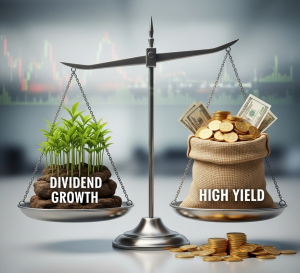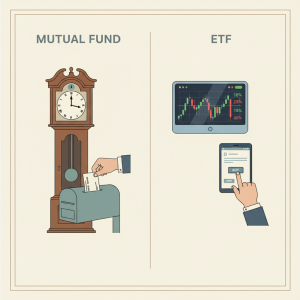Summary (TL;DR)
For investors, the key takeaway from recent Federal Reserve actions and commentary is that the central bank is no longer strictly adhering to its rigid 2% inflation target. Instead, it is adopting a more “flexible” approach that tolerates inflation running above target for a sustained period, especially in the face of a weakening labor market. This strategic pivot, although not a formal policy change, is the most significant development for long-term investors, as it suggests the Fed may be willing to cut interest rates to support employment even while inflation remains elevated, a stance that has profound implications for asset prices and the relative performance of different market sectors.
The Fed’s Unofficial Pivot: Why the Bond Market Sees a Labor Crisis, Not Just an Inflation Problem
While Wall Street was busy obsessing over last month’s CPI report, the bond market was telling a different story, one of a profound, and likely permanent, shift in Federal Reserve policy. The core news is not just that the Fed is no longer strictly adhering to its rigid 2% inflation target, but that the market has already priced in this change. The most visible and powerful signal of this new reality is the recent drop in long-term U.S.
Treasury yields, even as inflation remains elevated. This move in the bond market, where sophisticated institutional investors place their bets is the definitive sign that the central bank’s focus has fundamentally pivoted from fighting inflation at all costs to preventing a labor market collapse. This isn’t a temporary tactic; it’s a reordering of the Fed’s priorities, and it has set a new framework for how investors must think about the next decade.
The Core News: A New Priority Takes Center Stage
Over the past week, a series of speeches from Federal Reserve officials, including Chairman Jerome Powell, have signaled a new priority for the central bank: supporting a faltering labor market even if it means tolerating inflation above the long-held 2% target. While the official stance remains a long-term goal of 2% inflation, recent data, including a persistent rise in core inflation and a sharp slowdown in job creation has forced the Fed to rebalance its dual mandate of price stability and maximum employment.
The market’s reaction, with bonds rallying and stocks holding firm, indicates investors are interpreting the Fed’s rhetoric as a clear signal that rate cuts are more likely in the near term than previously expected, despite the persistent inflation.
By the Numbers: The Data Driving the Shift
Here are the key metrics that have driven the Fed’s pivot:
- Consumer Price Index (CPI): Rose 2.9% year-over-year in August.
- Core CPI: Increased by 3.1% over the last 12 months, which is well above the Fed’s 2% target.
- Jobless Claims: Recently saw a significant jump to 263,000 last week, to the highest level in nearly four years, signaling a potential slowdown in the labor market.
- Bond Market Reaction: Longer-dated U.S. Treasury yields have been falling as investors increasingly price in future rate cuts, reflecting a shift in focus from inflation to economic growth concerns. (Note: Bond yields move inversely to their prices, so falling yields indicate rising demand for bonds.)
- Fed Funds Rate Futures: According to the CME Group’s FedWatch tool, markets are pricing in a near-certainty of a quarter-point rate cut at the next Fed meeting. CME FedWatch tool is showing a 93.4% probability as of 2025-09-12.
Background: A Shift in Strategy
For years, the Federal Reserve’s monetary policy was governed by a predictable “flexible inflation targeting” framework. This meant the Fed would respond symmetrically to inflation, raising rates to fight inflation that was too high and cutting them to combat inflation that was too low. Coming into this month, after a period of sustained high inflation, many investors and analysts were expecting the Fed to maintain a cautious stance.
However, the labor market has shown signs of weakness, with jobless claims rising to their highest level in nearly four years. This created a tension for the Fed, which faces political pressure to support the economy. The new, unofficial strategy effectively prioritizes the employment mandate, acknowledging that a 3% inflation regime might be a new reality, at least for a time, to avoid a recession. This is what economists refer to as engineering a “soft landing.”
Historical Context: Lessons from the Past
This is not the first time the Fed has had to make a difficult choice between its two core mandates. The most famous example is the Paul Volcker era of the late 1970s and early 1980s, where he chose to crush inflation at the expense of a severe recession. Volcker’s actions were a direct response to the “Great Inflation,” a period where the Fed, under previous leadership, was too accommodating and allowed inflation to spiral out of control in an effort to keep unemployment low. The lesson from the Volcker era is that once inflation expectations become unanchored, the cost of bringing them back down is enormous.
A more subtle and relevant precedent, however, can be found in the post-2008 financial crisis period. During that time, the Fed adopted a new, unconventional approach known as “forward guidance.” It explicitly stated that it would keep interest rates near zero until specific conditions were met, such as the unemployment rate falling below a certain threshold and inflation moving toward its target. The current situation is a subtle mirror image of that period. Instead of promising to keep rates low until employment recovered, the Fed is now signaling it will cut rates even if inflation isn’t fully tamed, effectively using “flexible guidance” to support the labor market.
The Debate: Bullish Pragmatism vs. Bearish Caution

The Bull Case (The Optimistic View): Optimists believe this shift is a necessary and pragmatic response to current economic conditions. By signaling its willingness to tolerate higher inflation, the Fed gains the flexibility to cut interest rates to stimulate a faltering economy without panicking markets. This is seen as a way to engineer a “soft landing,” where the economy avoids a full-blown recession.
Analysts at Wells Fargo Securities, for instance, wrote in a recent commentary that “the precarious state of the labor market will motivate the Fed to cut interest rates in September and further into next year.” This view suggests that lower interest rates will boost corporate profits and consumer spending, which would be a net positive for the stock market.

The Bear Case (The Cautious View): Cautious voices point to the long-term risks of this strategy. They argue that by allowing inflation to run hot, the Fed risks losing its credibility and un-anchoring long-term inflation expectations. If consumers and businesses begin to believe that inflation will be persistently higher, it could create a self-fulfilling cycle of rising prices and wages that is much harder to control.
Conversely, a report from the OMFIF raises concerns that persistent fiscal deficits, tariffs, and de-globalization forces could push the U.S. toward a sustained 3% inflation regime, regardless of the Fed’s official target. This could force the central bank to make a difficult choice between fighting inflation and supporting employment, potentially leading to a more volatile economic cycle.
How Investors Should Position Themselves
A world where the Fed is more willing to let inflation run hotter for longer creates clear winners and losers across the market.
Winners in a Higher Inflation Environment:
- Financials: This sector benefits from a hotter inflation regime by more than just net interest margins. When the Fed signals it will support the economy, it emboldens banks to engage in more lending and risk-taking. With inflation providing a nominal tailwind, banks can extend more credit for mortgages, commercial loans, and corporate acquisitions. Money-center banks like JPMorgan Chase and Citigroup may be less directly sensitive to rate moves than regional banks whose profitability is tied more closely to lending.
- Energy and Materials: Companies in these sectors, which deal with physical commodities and assets, often benefit as the value of their products and assets rise with inflation. Their pricing power allows them to pass on higher costs to consumers, protecting profit margins.
- Real Estate: Property values tend to rise with inflation, providing a hedge for investors. Furthermore, those with fixed-rate mortgages see the real value of their debt decrease over time, a boon for homeowners and landlords.
Losers in a Higher Inflation Environment:
- Fixed-Income Assets: Long-term bonds, especially those with fixed interest rates, are particularly vulnerable. Inflation erodes the purchasing power of their future interest payments and principal repayment, making their returns negative in real (inflation-adjusted) terms.
- High-Growth Technology Stocks: These companies, especially those with no current revenue like early-stage startups, are the biggest losers. Their valuation is based almost entirely on the promise of immense future earnings. When inflation is higher, the discount rate used to value those future earnings also rises. A higher discount rate means that a dollar of earnings 10 or 20 years from now is worth much less today. This makes the long-term, speculative bet on a company like a pre-profit AI startup a much riskier and less attractive proposition. In contrast, a mature tech company with consistent revenue and cash flow, like Apple, is less affected because its valuation is not as dependent on a distant future.
Disclaimer: This article is for informational purposes only and does not constitute financial, investment, or legal advice. The information provided is a synthesis of publicly available data and expert analysis and should not be considered a recommendation to buy or sell any security. Investing in the stock market involves risk, including the possible loss of principal. Past performance is not indicative of future results. Readers should consult with a qualified financial advisor to determine an investment strategy that is suitable for their own personal financial situation and risk tolerance.






















